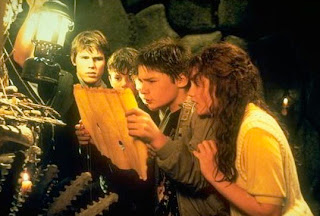The greatest thing about using puzzle type games as mechanics for LARP is that these games have a predetermined difficulty and are well known by the players. Less explanation means more immersion. Also, puzzles like this make everyone else feel involved, because they can actually gauge how well you're doing without having to understand some unique system.
1. Mastermind
This game is a gem that you can use to symbolize picking a lock or trying to enter a combination. The great thing about it is that the mechanic is simple enough that you don't even need the game itself in order to use it. But with a little work, you can build your own pimped-out mastermind game (either physically or in software).
2. Kerplunk
I like the idea of using this game to symbolize some sort of stealth action that the players are trying to perform. Make it so that each character going has to draw a stick, and if a marble falls, the players are spotted/heard. This makes the players gauge how many people they want to take, as the more you bring, the more likely it is that a marble will drop. Unfortunately, recreating Kerplunk could be kind of difficult, so you might have to suck it up and buy this one.
3. Jenga
Using Jenga as a representation of a power source of some kind could add a lot to a module. The more you use the power source, the more likely it is to break. It also adds an additional element of keeping the area around the power source safe, since that tower could easily topple if people are stomping too loud around the set. While you could build something like Jenga yourself, the wood blocks in that game have very high dimension tolerances and have just the right amount of friction to make it possible, but difficult.
4. Tangrams
Another favorite that's used by a lot of plot teams in this area is Tangrams. I prefer to use it as a way of channeling magical spells several times. That way, different shapes might activate a different part of the spell, and as the players perform the shapes, they'll get faster and faster at it. At the very basic level, make one shape open a door and the other shape close it. That way, they'll have to open it to let their friends in, but then they'll have to make the other shape to close the door and keep the NPCs out.
5. Simon
Using mechanics from any game that requires you to repeat patters can always make for an interesting mechanic. For more interesting results, have two games set up and have the PCs face off against the NPCs. Each player will go as far as they can, hoping the other will fail and cause them to suffer the consequences in a horse-esque battle of wits. That, or recreate the Goonies piano scene.
 |
| What the Hell is Blue, Blue, Red, Green, Blue? |
Got any games you like to use for plot puzzles?
Ok, seriously, I really like the Jenga idea as a way to represent a limited scope resource that doesn't feel like I'm arbitrarily decided when the warp coil fails out of spite.
ReplyDeleteNice!
Yeah, from my experiences anything that feels like a forced scenario detracts from fun. However, you do still need to scale the encounter in the case that some clumsy player knocks the table before many blocks are moved.
ReplyDeleteWe also provide corporate database and business contacts. If you are interested, then please contact us for detailed information
ReplyDelete